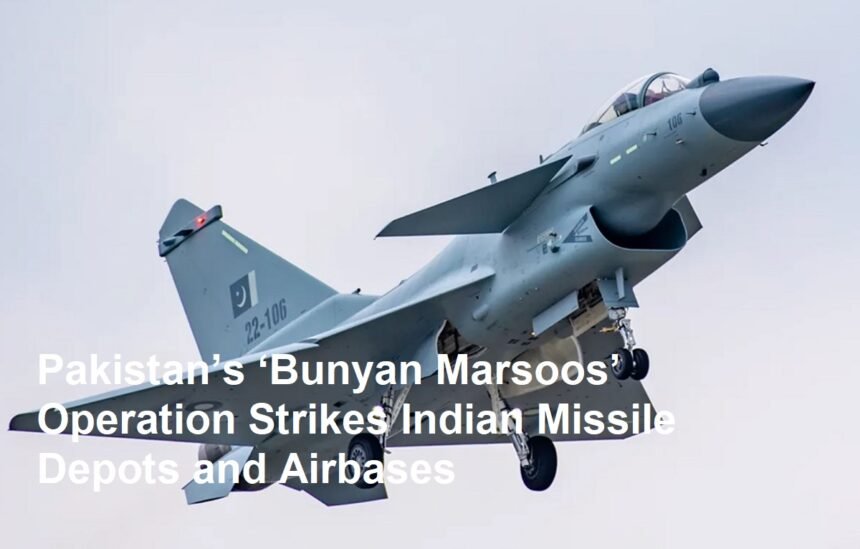On Saturday, May 10, 2025, Pakistan launched a significant military operation named “Bunyan Marsoos,” which translates to “a wall that cannot be knocked down” or “Iron Wall.” This operation marked a major retaliatory strike against India, targeting key military installations in the Indian state of Punjab and the region of Jammu and Kashmir. The primary objectives of the operation were to strike the BrahMos missile storage facility located in Beas, Punjab, and to attack the Udhampur Air Force Base and the Pathankot airfield, both situated in Indian-administered Punjab. This military campaign represents a critical escalation in the ongoing tensions between the two neighboring countries, reflecting deep-rooted geopolitical and security challenges in the region.
Background and Context
The India-Pakistan relationship has long been fraught with conflict, particularly over the disputed region of Kashmir. Both countries maintain substantial military forces along their borders and have engaged in multiple wars and skirmishes since their independence in 1947. The BrahMos missile system, a joint venture between India and Russia, is a supersonic cruise missile known for its precision and destructive capability. The storage facilities for these missiles, such as the one in Beas, Punjab, are considered high-value military targets due to their strategic importance in India’s defense infrastructure.
The operation “Bunyan Marsoos” was reportedly launched in response to what Pakistan described as Indian military aggression. The name itself symbolizes resilience and an unyielding defense posture, signaling Pakistan’s intent to demonstrate strength and deterrence against perceived threats.
Details of the Operation
According to multiple credible sources, including reports from Al Jazeera and Dunya News, Pakistan’s military executed coordinated strikes on May 10, 2025, targeting at least six Indian military bases. Among the most notable targets were the BrahMos missile storage facility in Beas and the Udhampur Air Force Base, along with the Pathankot airfield.
The BrahMos missile depot in Beas is a critical site where India stores some of its most advanced missile systems. The strike reportedly caused significant damage to this facility, disrupting India’s missile storage capabilities. Similarly, the airbases at Udhampur and Pathankot, both strategically important for India’s air defense and operations in the northern region, were also targeted and sustained damage.
Pakistan’s military reportedly employed Fateh-I missiles during the operation, a tactical ballistic missile system capable of precision strikes. The use of such advanced weaponry underscores the seriousness and scale of the operation.
Strategic and Military Implications
The destruction of the BrahMos missile storage facility and damage to key airbases represent a substantial blow to India’s military infrastructure in the region. These strikes not only degrade India’s immediate operational capabilities but also send a strong message about Pakistan’s willingness and ability to conduct precise and impactful military actions.
The operation also highlights the evolving nature of military engagements between India and Pakistan, where missile technology and air power play increasingly prominent roles. The targeting of missile depots and airbases indicates a strategic focus on crippling the opponent’s offensive and defensive assets, potentially altering the balance of power in the region.
Reactions and Diplomatic Fallout
The operation has inevitably escalated tensions between the two countries, with both sides likely to engage in diplomatic and military responses. While Pakistan framed the operation as a justified retaliation against Indian provocations, India condemned the strikes as aggressive acts violating its sovereignty.
International observers and regional powers have expressed concern over the escalation, urging restraint and dialogue to prevent further conflict. The operation “Bunyan Marsoos” may prompt renewed diplomatic efforts to address the underlying issues fueling the India-Pakistan rivalry, though the immediate aftermath is expected to be marked by heightened military alertness and potential retaliatory measures.
Historical Significance
This operation is notable for its scale and precision, reflecting advancements in Pakistan’s military capabilities and strategic planning. It also underscores the persistent volatility in South Asia, where longstanding disputes continue to manifest in military confrontations.
The targeting of the BrahMos missile storage facility is particularly significant given the missile’s reputation as one of the fastest and most accurate cruise missiles in the world. Damaging such a facility not only impacts India’s military readiness but also carries symbolic weight in the ongoing contest for regional dominance.
Conclusion
Operation “Bunyan Marsoos” represents a critical moment in the India-Pakistan conflict, demonstrating Pakistan’s resolve to respond decisively to perceived threats. By striking high-value military targets such as the BrahMos missile depot in Beas and the airbases at Udhampur and Pathankot, Pakistan has showcased its military capabilities and strategic intent.
The operation’s consequences will likely reverberate through the region’s security landscape, influencing military postures, diplomatic relations, and the broader geopolitical dynamics of South Asia. As both nations navigate the aftermath, the international community will be watching closely, hoping for de-escalation and a return to dialogue to prevent further conflict.









